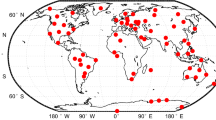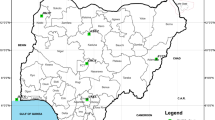Abstract
Atmospheric pressure is a widely used meteorological parameter, and surface pressure at antenna height is one of the most important parameters for calculating the Global Navigation Satellite System (GNSS) tropospheric hydrostatic delay. The latter is responsible for about 90% of the total tropospheric delay, which is one of the main error sources in geodetic applications. For convenience, a standard pressure formula is commonly applied to extrapolate pressure at any height from mean sea level (MSL). The higher the antenna is, the greater the error introduced into the calculated pressure. We study the pattern between the reference pressure, interpolated from the pressure level dataset, and the pressure extrapolated from MSL by applying a standard method at the position of 320 globally distributed GNSS stations from the gridded fifth-generation European Center for Medium-range Weather Forecasts Reanalysis (ERA5) numerical dataset. We optimize the standard method by taking height and temperature into consideration and propose two modified models based on 17 years of data. The results from pressure comparison at different height intervals and respective validation for the year 2020 show that the two modified methods exhibit a 60% improvement relative to the standard method. Moreover, the precise point positioning (PPP) test in July 2020 shows a slight but global improvement in 3D coordinates and retrieved precipitable water vapor.












Similar content being viewed by others
Data availability
The data that support the findings of this study are available on the ECMWF website (https://cds.climate.copernicus.eu/cdsapp#!/home).
References
Askne J, Nordius H (1987) Estimation of tropospheric delay for microwaves from surface weather data. Radio Sci 22(03):379–386
Berg H (1948) Allgemeine Meteorologie. Dümmler’s Verlag, Bonn
Böhm J, Niell A, Tregoning P, Schuh H (2006) Global mapping function (gmf): a new empirical mapping function based on numerical weather model data. Geophys Res Lett. https://doi.org/10.1029/2005GL025546
Böhm J, Heinkelmann R, Schuh H (2007) Short note: a global model of pressure and temperature for geodetic applications. J Geodesy 81(10):679–683
Böhm J, Möller G, Schindelegger M, Pain G, Weber R (2015) Development of an improved empirical model for slant delays in the troposphere (GPT2w). GPS Solut 19(3):433–441
Boisits J, Landskron D, Böhm J (2020) VMF3o: the Vienna mapping functions for optical frequencies. J Geodesy 94(6):1–11
Chen G, Herring T (1997) Effects of atmospheric azimuthal asymmetry on the analysis of space geodetic data. J Geophys Research: Solid Earth 102(B9):20489–20502
Chen B, Dai W, Liu Z, Wu L, Kuang C, Ao M (2018) Constructing a precipitable water vapor map from regional GNSS network observations without collocated meteorological data for weather forecasting. Atmos Meas Tech 11(9):5153–5166
Copernicus Climate Change Service (C3S) (2017): ERA5: Fifth generation of ECMWF atmospheric reanalysis of the global climate. Copernicus Climate Change Service Climate Data Store (CDS), https://cds.climate.copernicus.eu/cdsapp#!/home
Dach R, Lutz S, Walser P, Fridez P (2015) Bernese GNSS software version 5.2. Astronomical Institute, University of Bern
Dee DP et al (2011) The ERA-Interim reanalysis: configuration and performance of the data assimilation system. Q J R Meteorol Soc 137(656):553–597
ECMWF (2011) The ERA-Interim reanalysis dataset, copernicus climate change service (C3S). European Centre for Medium-range Weather Forecast. https://www.ecmwf.int/en/forecasts/datasets/archive-datasets/reanalysis-datasets/era-interim
Emardson TR, Elgered G, Johansson JM (1998) Three months of continuous monitoring of atmospheric water vapor with a network of global positioning system receivers. J Geophys Res Atmos 103(D2):1807–1820
Feng P, Li F, Yan J, Zhang F, Barriot JP (2020) Assessment of the accuracy of the Saastamoinen model and VMF1/VMF3 mapping functions with respect to ray-tracing from radiosonde data in the framework of GNSS meteorology. Remote Sens 12(20):3337
Hofmeister A (2016) Determination of path delays in the atmosphere for geodetic VLBI by means of ray-tracing. Ph.D. thesis, Vienna University of Technology
Hopfield H (1969) Two-quartic tropospheric refractivity profile for correcting satellite data. J Geophys Res 74(18):4487–4499
King J (2003) Validation of ECMWF sea level pressure analyses over the Bellingshausen Sea Antarctica. Weather Forecast 18(3):536–540
King R, Bock Y (2005) Documentation for the GAMIT GPS processing software release 10.2. Mass. Inst. of Technol, Cambridge
Lagler K, Schindelegger M, Böhm J, Krásná H, Nilsson T (2013) GPT2: empirical slant delay model for radio space geodetic techniques. Geophys Res Lett 40(6):1069–1073
Landskron D, Böhm J (2018) VMF3/GPT3: redefined discrete and empirical troposphere mapping functions. J Geodesy 92(4):349–360
Mendes VB, Prates G, Santos L, Langley RB (2000) An evaluation of the accuracy of the accuracy of models for the determination of the weighted mean temperature of the atmosphere. In: Proceddings of the 2000 National Technical Meeting of the Institute of Navigation vol 2000, pp 433–438
Petit G, Luzum B (2010) IERS conventions (2010). Tech. rep., Bureau International des Poids et mesures sevres (France)
re3data.org (2020) VMF Data Server; editing status 2020–12–14; re3data.org - Registry of Research Data Repositories. Doi. https://doi.org/10.17616/R3RD2H
Rothacher M (2002) Estimation of station heights with GPS. In: Drewes H, Dodson AH, Fortes LPS, Sánchez L, Sandoval P (eds) Vertical reference systems. Springer, Berlin
Saastamoinen J (1972) Atmospheric correction for the troposphere and stratosphere in radio ranging satellites. Artificial Satell Geodesy 15:247–251
Schüler T (2001) On ground-based GPS tropospheric delay estimation. Ph.D thesis, Universtät der Bundeswehr München
Younes SAM (2016) Modeling investigation of wet tropospheric delay error and precipitable water vapor content in Egypt. Egypt J Remote Sens Sp Sci 19(2):333–342
Yu L, Zhang Z, Zhou M, Zhong S, Lenschow D, Hsu Hm Wu H, Sun B (2010) Validation of ECMWF and NCEP-NCAR reanalysis data in Antarctica. Advances in Atmospheric Sciences 27(5): 1151–1168
Zhao Q, Yao Y, Yao W, Zhang S (2019) GNSS-derived PWV and comparison with radiosonde and ECMWF ERA-Interim data over mainland China. J Atmos Solar Terr Phys 182:85–92
Acknowledgements
The authors are grateful to the financial support from the Youth Innovation Project of the National Time Service Center (NTSC), the Natural Science Foundation of Shaanxi Province (2021JQ-322), the National Nature Science Foundation of China (12073034, 12003041), and the West Light Foundation of the Chinese Academy of Sciences (XAB2018YDYL01, XAB2019A06). The authors thank C3S (2017) and the Crustal Dynamics Data Information System (CDDIS) for providing data used in this article and thank for the support from the international GNSS monitoring and assessment system (iGMAS), iGMAS analysis center at NTSC, and the National Space Science Data Center, National Science and Technology Infrastructure of China.
Author information
Authors and Affiliations
Corresponding author
Additional information
Publisher's Note
Springer Nature remains neutral with regard to jurisdictional claims in published maps and institutional affiliations.
Rights and permissions
About this article
Cite this article
Su, H., Yang, T., Sun, B. et al. Modified atmospheric pressure extrapolation model using ERA5 for geodetic applications. GPS Solut 25, 118 (2021). https://doi.org/10.1007/s10291-021-01153-8
Received:
Accepted:
Published:
DOI: https://doi.org/10.1007/s10291-021-01153-8




